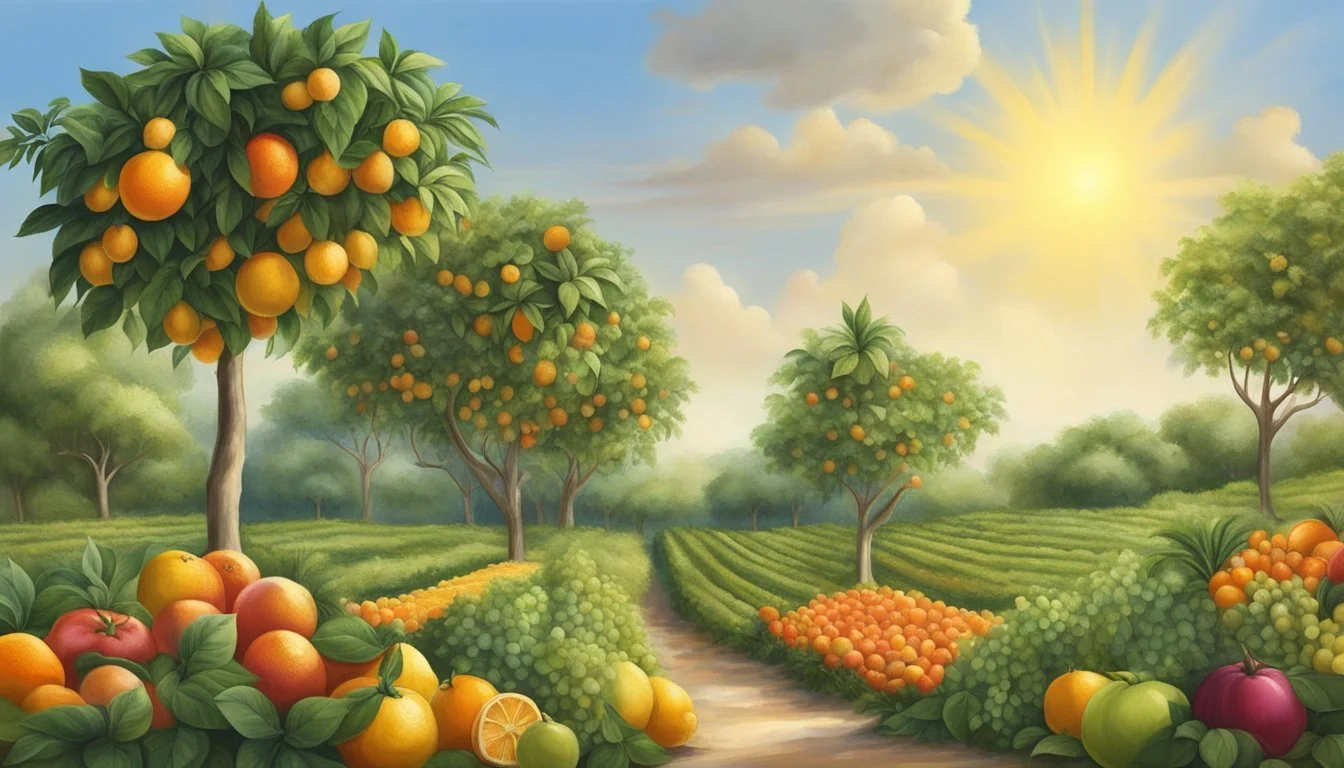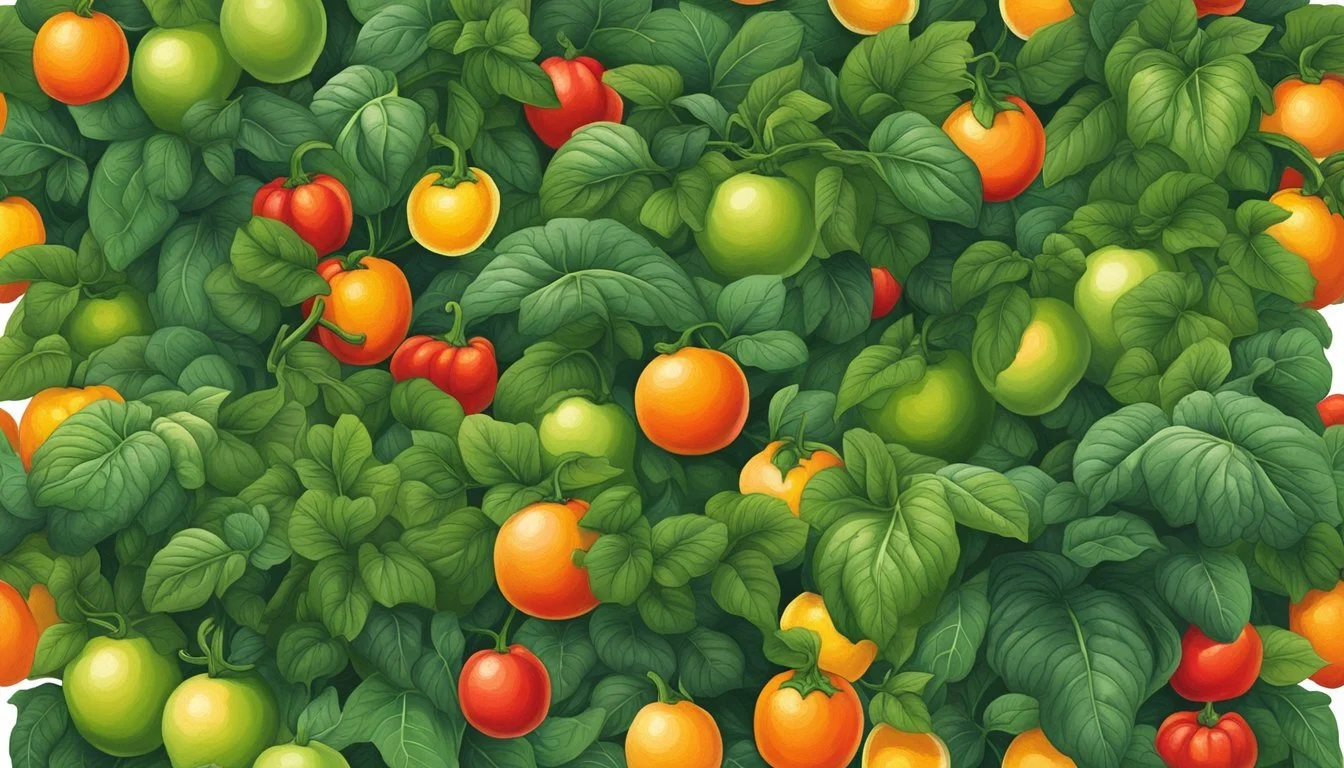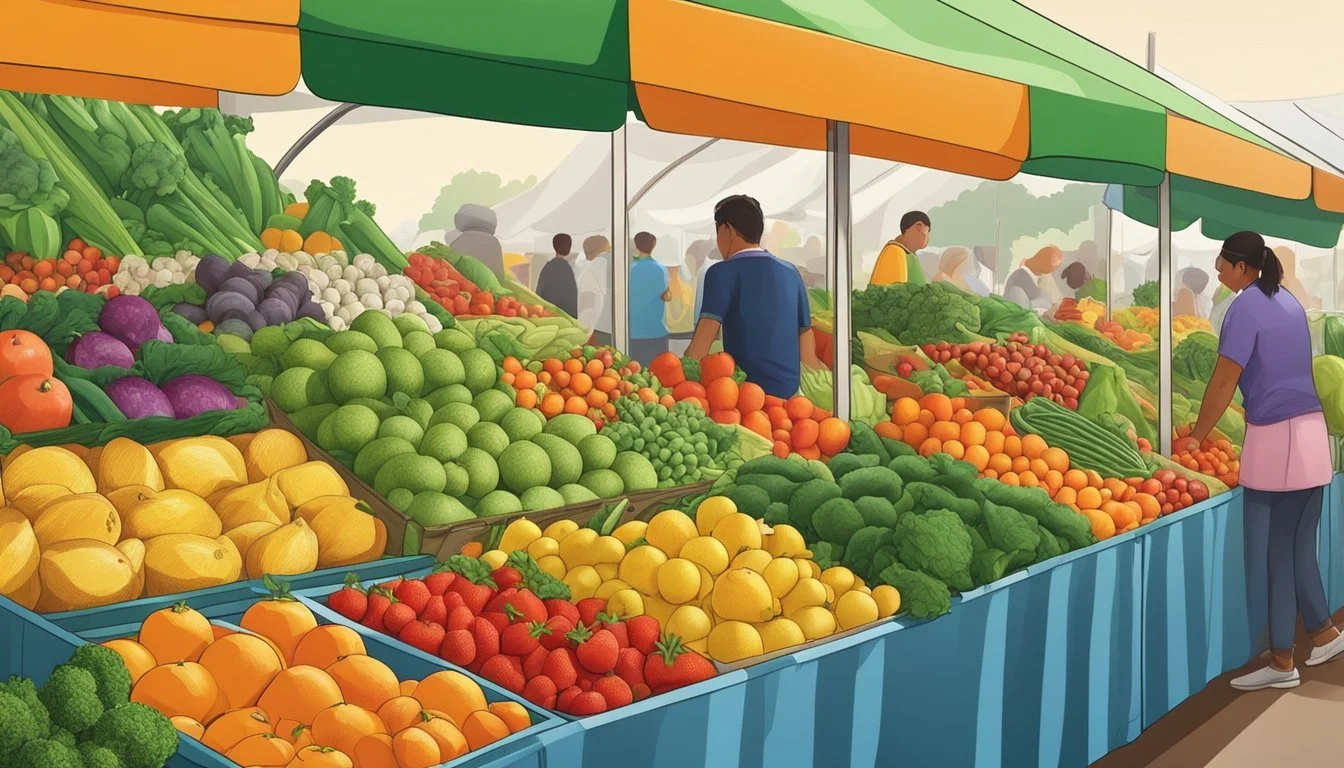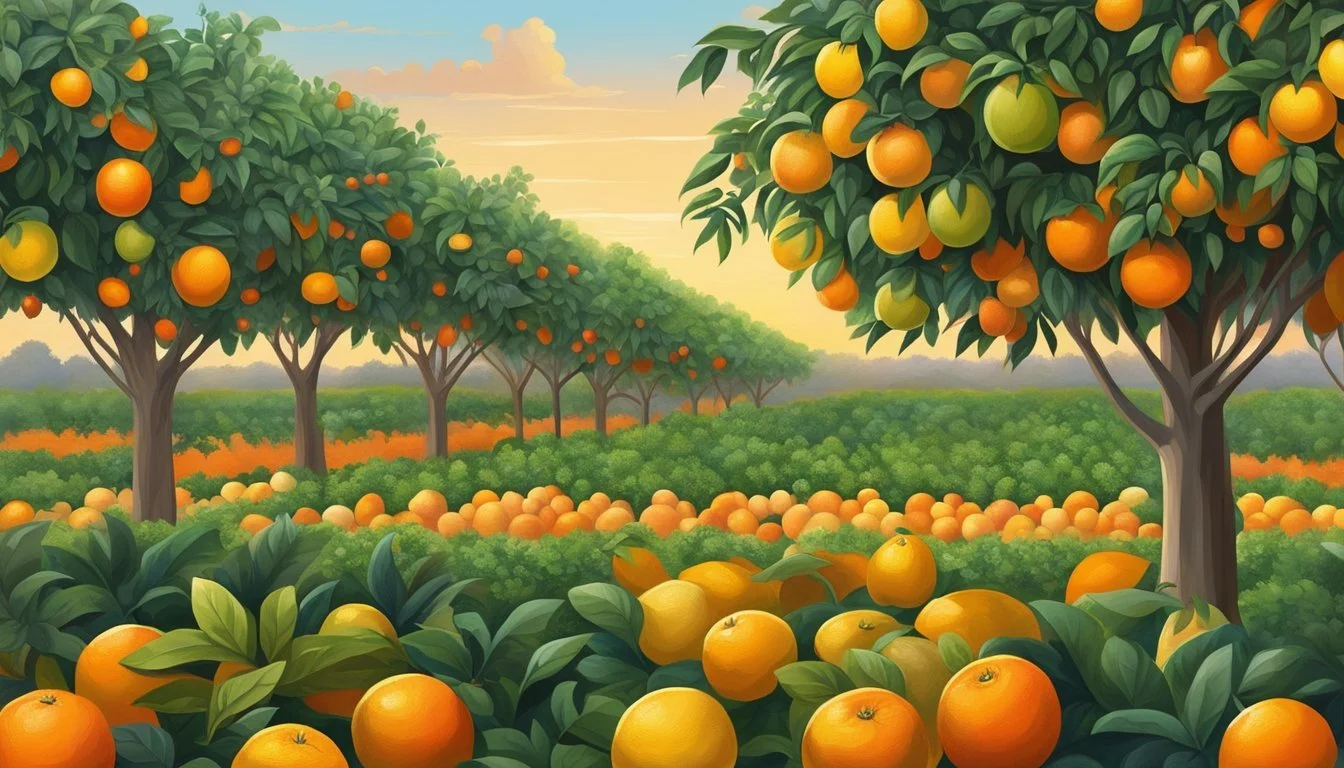Florida Seasonal Fruit & Vegetables in December
A Guide to Winter Produce
This Article is Part of our Florida Seasonal Fruit & Veg Calendar
Florida's agricultural richness brings a bounty of fresh produce that varies with the seasons, and December offers its own unique selection. This month, consumers can relish in the peak flavors of winter harvests, benefiting from both the nutritional quality and the heightened taste that comes with consuming foods during their natural growing period. With a climate that supports a long growing season, many fruits and vegetables are available through December, including root vegetables, leafy greens, and various citrus fruits which are a staple of the region.
The winter season in Florida sees a plethora of vegetables and fruits that thrive in the cooler weather. Vegetables such as cauliflower (how long does cauliflower last?), celery (how long does celery last?), and celeriac are harvested through to May, while leafy greens like collards are available until May, perfectly aligning with the December harvest. Cucumbers extend their reach into June but begin availability as early as October, offering a refreshing crunch in the winter months.
Citrus fruits stand out as a defining feature of Florida's December produce, with the state being a major supplier of these juicy gems. Oranges, grapefruits, and tangerines are among the variety of Florida citrus fruits that reach their peak during the winter months. They not only provide an explosion of vitamin C but also bring a taste of Florida sunshine to tables across the country during the colder days of December.
Understanding Florida's Unique Climate
Florida's climate is characterized by warmth and humidity, which significantly influences its agricultural patterns. The state is divided into various climatic zones, ranging from tropical in the southern regions to subtropical in the north.
Growing Season: Florida boasts a year-round growing season due to its mild winters, enabling continuous production and harvesting of a variety of fruits and vegetables. The condition of the soil, along with the climate, allows for robust agriculture across the state.
Regional Variations:
South Florida: Known for its tropical climate, it provides an ideal environment for growing a wide range of tropical fruits.
North Florida: It experiences cooler temperatures, which are conducive to the production of temperate fruits and vegetables.
Agriculture thrives under these conditions, with the state producing a substantial portion of the country's citrus, strawberries, tomatoes, and sugarcane. Florida's distinct climatic attributes result in a unique agriculture scene that supplies fresh produce both locally and nationally.
Region Climate Notable Produce South Florida Tropical Citrus, Mangoes, Avocado North Florida Subtropical Broccoli, Cabbage, Leafy Greens
The state's extended sunlight hours, coupled with its well-draining sandy soils, create an optimal setting for various crops outside the traditional growing seasons observed in other parts of the United States. This has established Florida as a crucial player in the nation's supply of fresh produce throughout the year.
Seasonal Produce Calendar
In December, Florida offers an abundance of fresh produce as the state transitions from fall to winter. This is reflected in the variety of fruits and vegetables reaching their peak during this month.
Fruits in Season:
Citrus: Oranges, tangerines, grapefruits, and lemons are all vibrant and full of flavor.
Strawberries: These berries start their peak season, offering a sweet taste of what's to come in spring.
Tomatoes: Though commonly mistaken as a vegetable, Florida's tomatoes are plump and ripe for picking.
Vegetables in Season:
Leafy Greens: Spinach and varieties of lettuce are readily available, providing a perfect base for winter salads.
Root Vegetables: Beets and radishes, staples of the cooler season, can be harvested at this time.
Cabbage: Both green and red cabbage can be found, adding crunch and color to dishes.
Broccoli and Cauliflower: These cool-weather crops are in full swing.
The calendar for Florida's produce showcases a shift from the typical fall harvest to cool-season crops that thrive in the mild winter climate. The resident or visitor to Florida can confidently rely on locally grown, fresh options at markets and restaurants.
Additionally, many vegetables, such as collard greens (how long do collard greens last?), chard, and cilantro, remain available, having been cultivated in the preceding fall months. They continue to grow well into Florida's winter season. With the knowledge of what is freshly in season, consumers can not only enjoy optimal flavors but also support sustainable and local agricultural practices.
December's Seasonal Fruits
Florida, known for its abundant sunshine, offers a variety of fruits during December. Citrus fruits, flourishing in this month, are a staple. They include oranges, grapefruit, and tangerines, each packing a powerful punch of Vitamin C to support immune health during the cooler season.
Oranges are notably versatile, enjoyed fresh, as juice, or in marmalades. Their vibrant color and juicy taste make them a favorite. Grapefruit, another popular choice, comes in several varieties ranging from white to pink and red, each with a unique blend of sweetness and tanginess. Tangerines are smaller, easier to peel, and sweeter than oranges, making them a delightful snack for all ages.
Beyond these classic citrus options, December also brings tropical fruits to the forefront. Guava, with its distinct fragrance and flavor, is a gem of the tropics and can be found in markets around Florida this time of year.
Fruit Description Uses Availability Oranges Sweet, tangy, high in Vitamin C Juices, marmalades, fresh High Grapefruit Ranges from bitter-sweet to very sweet Salads, juices, fresh High Tangerines Sweet, less acidic than oranges, easy to peel Snacks, desserts, salads High Guava Fragrant, sweet-tart flavor Juices, jellies, eaten fresh Moderate
Furthermore, strawberries come into peak season. They are perfect for a range of uses, from fresh eating to making jams and festive desserts. Their bright red color and sweet, slightly tart taste make them a holiday favorite.
This selection of fruits not only provides delightful flavors but also numerous health benefits. Consumers have the opportunity to indulge in the fresh, local produce that December in Florida generously offers.
December's Seasonal Vegetables
In Florida, December is not just about holiday feasts and festive decor; it’s also a month that offers a variety of fresh vegetables due to its mild winter climate. Local markets brim with produce that is both vibrant and flavorsome. Gardeners and farmers in the region harvest a range of vegetables that include:
Broccoli: This nutrient-packed vegetable thrives in cooler temperatures, making it a December staple. Its tightly packed florets are ripe for picking in this month.
Cauliflower: Similarly to broccoli, cauliflower flourishes in Florida's winter, presenting heads of creamy, white curds that are versatile in the kitchen.
Cabbage: With its resilient nature, cabbage is well-suited for colder months. Shoppers can find fresh varieties ranging from green to purple hues.
Carrots: Root vegetables like carrots prosper in the cooler soil. Florida-grown carrots are sweet and perfect for various holiday dishes.
Celery: Known for its crisp stalks, celery is in season and adds a refreshing crunch to holiday stuffings and salads.
Green Beans: Though typically associated with warmer seasons, green beans have a surprising winter presence, offering their tender pods for an array of side dishes.
These vegetables are not only abundant in Florida's December markets, but they are also at their nutritional peak, offering an excellent choice for anyone looking to incorporate fresh, local produce into their meals. Cooks and food enthusiasts can revel in the abundant selection that this winter month provides.
Organic and Local Farming Practices
In Florida, agriculture thrives with a focus on organic and local farming practices. These initiatives emphasize sustainability and community engagement, with farmers and consumers enjoying the benefits of locally-grown produce.
Sustainable Agriculture
Sustainable agriculture is an integral part of Florida's farming ethos. Local farmers implement various practices to maintain soil health, conserve water, and reduce the ecological footprint. Crop rotation and the use of natural pest management techniques minimize the need for chemical inputs, promoting a healthier ecosystem. Composting organic waste contributes to soil fertility, reducing reliance on synthetic fertilizers.
Local Farmers and Farmers Markets
Local farmers in Florida play a pivotal role in bringing fresh, organic produce to consumers. They often collaborate with farmers markets, where seasonal fruits and vegetables are directly available to the public. December offerings typically include:
Citrus fruits such as oranges, grapefruits, and tangerines
Root vegetables like radishes and carrots
Various leafy greens including lettuce and collard greens
Farmers markets not only support the local economy but also allow for a farm-to-table experience that ensures peak freshness and flavor. By purchasing from these markets, consumers directly contribute to sustainable agriculture practices.
Health Benefits of Seasonal Eating
Eating seasonally offers numerous health advantages. Fresh produce harvested during its peak season often contains more vitamins and nutrients compared to off-season counterparts. When fruits and vegetables are allowed to ripen naturally on their parent plant and are harvested when they're ready, they are at their nutritional best. Seasonal eating ensures that individuals enjoy a variety of foods throughout the year, which supports a balanced diet.
Higher Nutrient Levels: Seasonal fruits and vegetables have been found to contain more vitamins, such as Vitamin C, which is crucial for a strong immune system.
Better Taste: Seasonally fresh produce is typically more flavorful. The enhanced taste can encourage a higher consumption of healthy fruits and vegetables.
Supports Local Farming: Choosing seasonal items often means supporting local farmers and minimizing the environmental impact associated with long-distance transportation.
Eating seasonally in Florida during December means individuals can enjoy locally sourced produce like citrus fruits, which are high in Vitamin C facilitating immune health. Vegetables like broccoli and leafy greens, available in winter, provide essential vitamins and minerals that aid in reducing inflammation and promoting liver health. By incorporating a variety of seasonal fruits and vegetables into their diet, consumers not only experience peak freshness but also contribute to a sustainable food system.
Cooking with December Produce
In Florida, December brings an abundance of fresh vegetables and citrus fruits, offering a culinary playground for both seasoned chefs and home cooks.
Seasonal Recipes
December in Florida is not just about holiday feasts; it's an excellent time to explore the fresh flavors of seasonal produce in everyday cooking. Here are some recipes that highlight December's bounty:
Cauliflower can be transformed into a creamy soup or roasted with a dusting of parmesan.
Celeriac, also known as celery root, lends an earthy flavor to mashed potatoes or can be julienned for a fresh remoulade.
Celery is perfect for a classic Waldorf salad or a crunchy addition to stir-fries.
Cilantro brings a zesty twist to salsas and marinades for meats.
Chard can be sautéed with garlic for a simple side or incorporated into hearty stews.
Coconuts are harvested year-round and can be used for sweet desserts or savory curries.
Collard greens: try them braised with bacon or in a flavorful collard green dip.
Corn: fresh corn kernels can amplify soups or be the star of a corn salsa.
Cucumbers: pickled for longevity or sliced fresh into salads for a crisp texture.
Preservation Techniques
To make the most of December's harvest, preservation techniques allow cooks to extend the lifespan of their produce.
Cauliflower and Celeriac: can be pickled or turned into relishes.
Celery: preserve by dehydrating into a spice or freezing for later use in stocks.
Cilantro: make a pesto and freeze in ice cube trays for later use.
Chard: blanch and freeze for a supply of greens year-round.
Coconuts: grate and freeze the flesh, or dry into flakes.
Collard greens: blanching and freezing retain their nutrients and flavor.
Corn: blanch and freeze the kernels or make corn relish.
Cucumbers: are ideal for traditional pickling or for fermenting as kimchi.
Buying Tips for Seasonal Produce
When purchasing seasonal produce in Florida during December, consumers should look for freshness and support local agriculture whenever possible. Here are some focused shopping tips:
Local Markets: Shoppers are encouraged to visit local farmers' markets. These markets often offer the freshest options since the produce is harvested at its peak and travels a shorter distance to reach the consumer.
Inspect Quality: Buyers should examine fruits and vegetables for signs of freshness such as bright color, firm texture, and a fragrant smell. Avoid produce with bruises, blemishes, or signs of withering.
Storage Knowledge: Know how to store your produce properly. For example, greens should be refrigerated and kept in a crisper where they can maintain moisture and freshness.
In-season Picks: December yields a variety of produce. Seek out in-season items for the best quality and price. Some of the produce available in December may include:
Vegetables Fruits Chard Cilantro Collard greens Coconuts Eggplant Cucumbers Corn Dragon fruits Fava beans (how long do fava beans last?)
Consumer Services: The Florida Department of Agriculture and Consumer Services offers resources for identifying in-season produce and can guide to when and where to shop for the best selection of seasonal items.
When following these guidelines, buyers will not only enjoy the taste and nutritional benefits of fresh produce but will also support the local economy and healthier food systems.
Contribution to Florida’s Economy
Florida's agricultural economy is notably robust, with its fruit and vegetable sectors making significant contributions. According to data, Florida boasts a diverse array of fruits and vegetables, enjoyed not only within the state but also across the nation and internationally. The production and sale of these commodities play a pivotal role in bolstering the state economy.
The Florida Department of Agriculture and Consumer Services underscores the economic impact of the state’s citrus industry. Citrus fruits, among other produce, have proven to be vital, with an impressive monetary contribution. For instance:
Citrus juice manufacturing: $5.334 billion
Citrus fruit production: $1.425 billion
Fresh citrus marketing: $177 million
Additionally, the citrus industry sustains a substantial number of jobs. In total, more than 32,000 full-time and part-time positions stem from the agrarian sector, evidencing the employment significance besides the monetary impact.
Beyond citrus, Florida is a national leader in several other crops during the winter months:
Sweet corn and watermelon: Over 36% of U.S. value of production
Bell peppers and grapefruit: Constitutes 33% of U.S. market value
Strawberries: Represents 12% of U.S. market value
These figures testify to the strategic importance of Florida’s fruit and vegetable production within the broader framework of the United States' agricultural output. Despite facing challenges such as diseases, extreme weather conditions, and land development pressures, Florida's seasonal produce continues to be a cornerstone of the state's economic landscape.
Future of Florida Farming
Florida farming is set to embrace sustainability as a core principle, moving towards more eco-friendly practices. Farmers are increasingly adopting crop rotation, organic farming, and integrated pest management techniques to enhance soil health and reduce chemical usage. These practices not only improve the quality of produce but also ensure the long-term viability of the farming land.
In terms of innovation, the agriculture sector is integrating advanced technologies such as precision agriculture, drones, and robotic systems to increase efficiency and yields. This technology helps in monitoring crop health, optimizing water usage, and managing resources more effectively. Hydroponics and vertical farming also show promise in urban areas, maximizing space and resources.
The economic trends indicate a growing market for locally-sourced and organic produce. Florida farmers are likely to benefit from this trend due to the state’s unique climate allowing year-round farming. It's expected that there will be an increase in small-scale farms and co-ops, selling directly to consumers and restaurants, fostering a community around local agriculture.
Aspect Trend or Innovation Sustainability Organic farming, crop rotation, and pest management Innovation Precision agriculture, drones, robotics, hydroponics Economic Trends Direct-to-consumer sales, local sourcing
These developments in Florida's farming landscape show a commitment to environmental stewardship, innovative growth, and economic adaptability — key factors that will shape the future of agriculture in the region.











